Italy
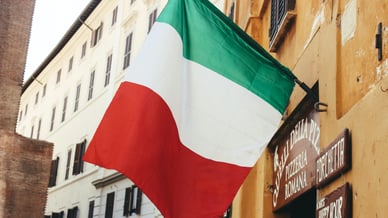
A boot-shaped peninsula on the map of Southern Europe, well-known from geography classes at school. A homeland of spaghetti and pizza. A fashion queen in the disco 1980s…
Also, it is the ancestor of one of the world’s greatest civilizations. A homeland of science and art geniuses like Leonardo da Vinci, Dante Alighieri, Antonio Stradivari. Everybody has their own idea about Italy. However, nobody will ever doubt that this is one of the most beautiful countries on Earth.

General Information
One of the most ancient European countries commenced its history in the 2nd millennium BC when the Apennine Peninsula was selected by its first inhabitants - the Italic peoples - to settle in.
During 1,500 years of its existence, Italy has transformed from a small tribal union into the third largest and most important EU economy. Now it is a parliamentary republic and secular state. It is Rome where the world’s centre of Catholicism - Vaticano - is located.
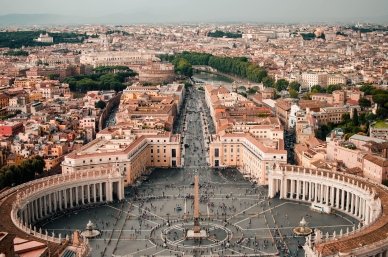
Vatican City
The official language is Italian.
However, there is so-called trouble with languages of communication because Italians speak English as the international language very rarely. Visitors to Italy will have to take this fact into account, and it will be very difficult to get by without a translator.
Italy has land borders with Austria, Slovenia, Switzerland, and France. The peninsula is surrounded by the Adriatic, Tyrrhenian, Ionian, and Ligurian Seas, all of which are parts of the Mediterranean Sea.
Italian terrain is mainly mountainous. To the north, on the Italian-French border, there is the highest summit of the southern Alpine slopes - Mont Blanc. The Apennines and their well-known hiking trails stretch along the eastern coast. The most famous is Grand Italian Trail that starts in Trieste, meanders along the Alpine region, Apennines, and Sicily, and ends in Sardinia.
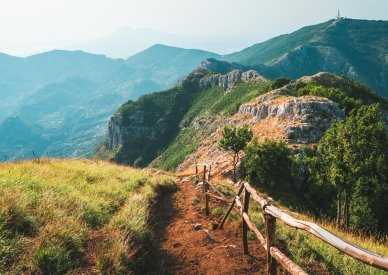
Sentiero Italia - Grand Italian Trail
Volcanoes are the other peculiarity of Italian geography. There are five of them, and Vesuvius and Etna are active. Earthquakes are not a rare thing and occur once in five or seven years. The last one took place in Abruzzo in 2016.
Italian climate is Mediterranean with torrid summers and very scarce rains when the temperature reaches +26°C - +30°C. People who live in southern parts of the country and the tourists who arrive there experience the biggest difficulties because of sirocco - a hot and dry wind that comes from the Sahara. As a rule, it is the peak of boiling hot weather, and it is necessary to be ready for the temperature of +35°C - +39°C.
A rainy season in the Appennines region takes place only in winter when the temperature reaches +2°C - +8°C. The weather might be somewhat freezing and snowy during that time.
Italy is among the first EU member states, so the Schengen visa is needed to enter the country.
The euro has substituted the lira and has become the Italian official currency.
Directions
Italian provinces are becoming more and more popular, so the passenger market has been developing rapidly.
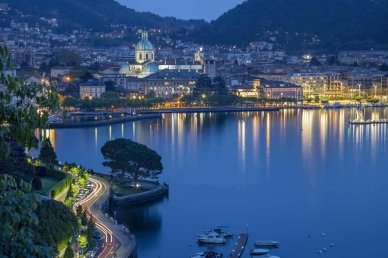
The city of Como, Italy
Travelling by Bus
Buses have become a very popular option among travellers across Europe. Travelling by bus is safe and cost-effective, so tourists may embark on a journey to Italy from many European countries.
Travelling by Plane
Italy has been a popular destination for people from all continents, so air travel is well-developed. The main Italian airports are Rome–Fiumicino International Airport "Leonardo da Vinci", Milan Malpensa Airport, and Venice Marco Polo Airport.
For example, the ticket price of flights from New York, Boston, or Toronto to Rome will vary from €280 to €380.
There are also many low-cost flights for European travellers, so it will not be a problem to get to Italy from any European country.
Travelling by Train
The railway network in Italy enables travellers to get there from the neighbouring countries and across the Italian peninsula by high-speed international and regional trains.
When planning a trip to Italy by train, it is recommended to book a ticket online in advance; however, you may purchase it at the railway station as well.
For example, the Bernina Express connects Switzerland and Italy and enables passengers to immerse themselves in the beauty of the Alps. Trenino Verde is the tourist train that crosses the entire island of Sardinia. And Cinque Terre Express carries its passengers along the Ligurian coast.

Accommodation
The ongoing pandemic that has shrouded Europe has also transformed the price lists of Italian hotels completely. Prices have been reduced by half and even more.
The rooms in great hotels of Venice, Rimini, and Rome will cost $30 - $40 per night. A place in a hostel will be much cheaper - $9.
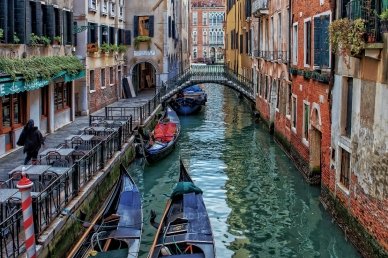
Venice, Italy
Below are a few good places where you will be able to have a good wash and a good sleep on comfortable beds with fresh linen at a reasonable cost. Some will also offer a tasty breakfast for free.
- Anda Venice Hostel is a greatly designed budget hostel with quality service in Mestre, the borough of Venice. Each room has a bathroom, a hairdryer, and air conditioning. Piazza Ferretto with its numerous trattorias, bars, and other places of entertainment is located nearby. It is a 40-minute bus ride from the Doge’s Palace.
- Happy Village e Camping Roma is a three-star hotel in Rome. The rooms are clean and cosy with showers, air conditioning, and balconies. Guests with children are offered cots. However, there is one disadvantage - the hotel charges additional fees for Internet access and Wi-Fi.
- Naples Experience is a three-star hotel in Naples. There is a heating and bathroom in each room, and balconies almost everywhere. While Wi-Fi and Internet access are free, breakfasts are available for a separate fee.
- Rimini Suite Hotel is a four-star hotel at affordable prices with nice rooms and trained staff on the shore of the Adriatic Sea in Rivabella, a two-minute walk from Rimini beach. Breakfasts and Wi-Fi are free.
- Romy Accommodation is a hotel located not far from the Tropea city centre and beach. The guests provide valuable feedback for the home environment, friendly staff, tasty cuisine, and out-of-the-ordinary cleanliness in the rooms.
Apart from the hotels, the Italian guests may also rent an apartment. The rent is cheaper on the daily basis, particularly if to book in advance.
The other Italian feature is agriturismo or farmhouse accommodation. Tourists rent a room or a small house from the farmers and pay for cheap rent and food. This type of rest is not expensive and, what is more, very healthy. Fresh air, vegetables and fruit picked from the garden will make an ordinary village great fun.
Places to See
Having a 1,500-year history, this country will always amaze not only its visitors but even those who have lived here since birth.
Italy shares the world’s top position with China in the number of UNESCO World Heritage Sites (there are 55 of them).
Tourists are attracted by the historical monuments of olden times, the Italian seas, and mountain resorts where a good rest and improvement of health are guaranteed.
Below are a few good recommendations from those who have had their time to explore the Appennines themselves, not from the stories of tour guides:
Rome
Acquaintance with the country should start with its capital. In the case of Italy, there is a very peculiar reason because Rome is the ancestor of the most prominent world civilizations.
Colosseum and Roman Forum are the most famous monuments of antiquity. Those constructions used to be the centre of the social and cultural life of the mighty empire. Now they enable visitors to feel the history of the world.
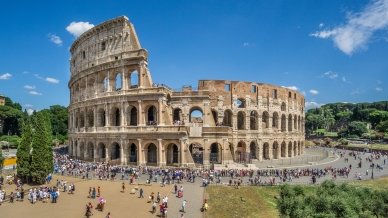
The Roman Colosseum
Pantheon is a perfectly preserved temple and tomb. It is the place where Raphael with his fiancee, painters Peruzzi and Carracci, two Italian kings - Umberto I and Vittorio Emanuele II, and Queen Margherita of Savoy are buried.
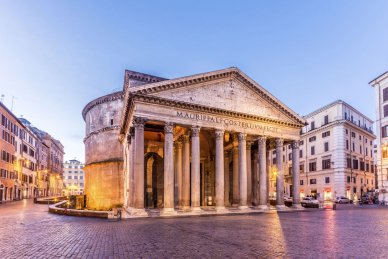
Pantheon, Rome
Piazzas and fountains - Piazza del Popolo, Piazza Barberini, the Quattro Fontane (the Four Fountains), and the Trevi Fountain can be regarded as the visiting cards of the capital city.
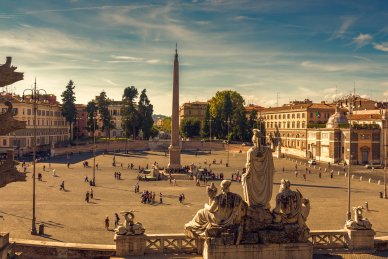
Piazza del Popolo, Rome
The Sapienza University of Rome is the alma mater for around 150,000 students. Established in the 14th century, it has kept the special atmosphere of the old classical European universities.
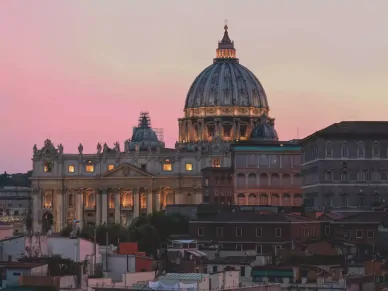
The Sapienza University of Rome
Vatican Museums house the unique collection of paintings and frescoes of the 14th-19th centuries, the Gallery of Maps, the Gallery of the Tapestries, and many other masterpieces. A guided tour will take more than five hours of time and more than seven kilometres on foot.
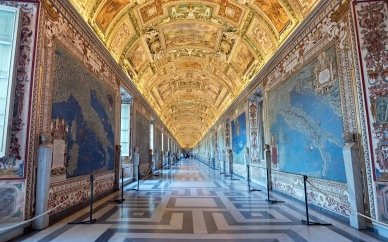
Gallery of Maps, Vatican City
The National Roman Museum is a huge collection of paintings and sculptures opened in the building of the former 19th-century monastery.
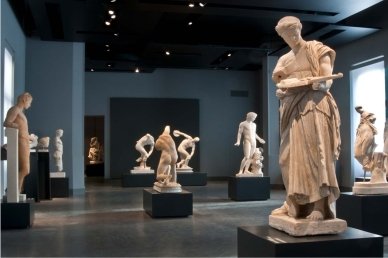
Palazzo Massimo alle Terme houses part of the National Roman Museum
Guided tours to the Baths of Diocletian, the Capitoline Museums, and the National Etruscan Museum in Villa Giulia will fascinate those who come to Rome for the first time.
Lazio
The main administrative region of Italy, where its capital is situated, might be called the open-air museum and resort at the same time, even without visiting Rome.
Tourists should definitely go to Tivoli (the town founded earlier than Rome) to see Villa d’Este and Hundred Fountains or to undergo medical treatment.
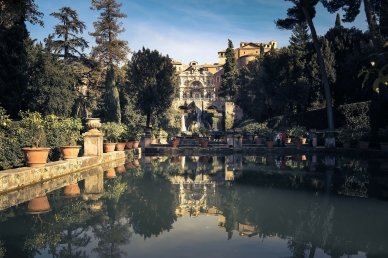
Villa d’Este, Tivoli
Tivoli is a large Italian balneological resort where warm sulfur water helps cure the diseases of the stomach, bones, spinal cords, skin, and respiratory system.
Campania
This is one of the most stunning corners of Italy where mountains coupled with islands have created unprecedented terrain and recreational space.
Its capital, Naples, is the place where the world’s number one flatbread called pizza was invented.
In this third largest Italian city, one should also enjoy drinking a cup of excellent coffee and sunbathing on the local beaches.
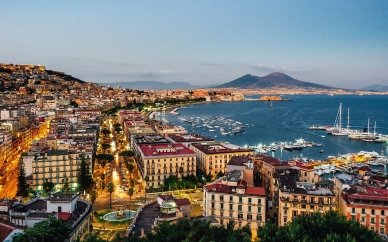
Naples, Italy
A lot of people come to Campania to have rest on the island of Capri and delight in the local rocky landscapes. VIP tourists have taken fancy to the small town of Amalfi with a population of 6,000 people. It is never scorchingly hot in summer there, so the conditions to take a good rest are just perfect.
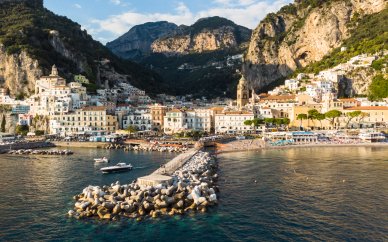
Amalfi Coast
Abruzzo
This region may be briefly described as Europe’s green belt because of the multitude of Italian national parks concentrated there. The local climate, proximity to the sea and mountains have shaped a distinctive atmosphere for people who aspire to privacy or the thrill of adventures. The latter one will be provided by fascinating guided tours along the Apennines mountain paths.
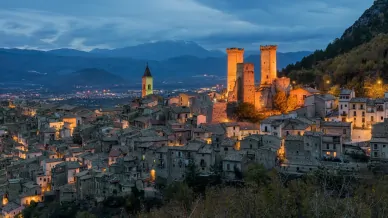
Abruzzo, Italy
There are many beautiful places to see in each Italian region. Any city or town has its own history, monuments, and local attractions. You will be under the same overriding impressions as after the guided tour to Rome.
Food
Many people think that Italy is about pizza and pasta unless they visit this Mediterranean corner.
In fact, Italian cuisine is considered one of the oldest and most versatile in Europe.
At least we precisely know that it triggered the development of many other European cuisines like Spanish, French, and Portuguese.
Though Italian food is plain, it contains many healthy products: vegetables, fresh herbs, many types of fruit and cheese, seafood, and fish. As a rule, the food is boiled and roasted, sometimes - fried. It is a common practice to serve fresh vegetables. Those principles have formed the Mediterranean diet, one of the healthiest in the world. People of all Mediterranean countries, not solely Italy, keep to this way of dieting.
So what is the menu of ‘italiano vero’ - a true Italian? Remarkably, a legendary pizza may hardly take the first place.
Italians eat much. This is the number one rule for everybody who is coming to Italy even for a couple of days.
A daily menu of a typical Apennines resident consists of light breakfast, and substantial dinner and supper.
For breakfast, Italians usually drink coffee with sandwiches (wheat bread and cheese). Dinner is always substantial and involves antipasti, minestra (a thick Italian soup), a portion of risotto or pasta with vegetables, fish, seafood, and sauces as the second course.

Minestra Soup
The other option is fried or roasted meat with vegetable garnish. A dessert will include sweeties, cold sweet beverages, pastry, and ice cream.
A supper is as substantial as a dinner. They eat almost the same dinner dishes (usually, there are not less than five) but in smaller portions. And they drink coffee endlessly during the whole day, be it espresso or cappuccino. It has to be strong, thick, and sweet as a must, with much foam. Why else would Italy become the world leader in coffee consumption?

Italian coffee
Every region and city has its own specialties worth trying in local restaurants and trattorias:
- The best pizza in the world, excellent coffee and cappuccino are made in Naples.
- Rome is famous for gnocchi.
- Venice is the place for delicious rice with green beans.
- Ligurians are proud of fish and seafood boiled in olive oil in a very special way.
- When in Lombardy, it is a must to order busecca - a tripe stew with white beans and herbs.
- The best treat in Umbria is mazzafegati - pork sausages.
And this is hardly a complete list of dishes cooked in Italian families, cafes, and restaurants. Local cuisine overwhelms with the diversity of recipes.
Wines are worth mentioning too. Italians drink a lot of wine as well as a lot of coffee. And this is the number two rule in Italy.
They began to drink wine before dinner: some aperitif is always a good idea. There are several wines served to be chosen for the main course - red, white, rose, dry, or semi-dry. Is it too hot? A glass of iced Lambrusco or Fragolino will help. Bad mood? Drink some wine to ease the tension. Anyway, in any incomprehensible, or even comprehensible situation, drinking wine is a way out. That is the idea of all Italians, no matter where in the world they end up living.
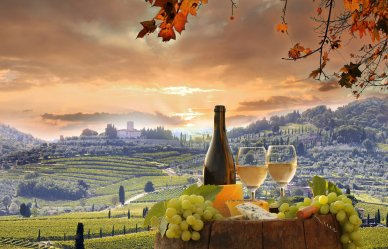
Italian wine
Driving when a little bit tipsy in Italy is okay: a couple of glasses will help to be in high spirits.
This sunny, bright, and unforgettable country of cheerful, temperamental, and sometimes crazy people is a magnificent corner of Mediterranean nature. It is a land where people eat much delicious food and find sheer pleasure in their drinking habits. Those things make Italy as it is.
FAQ
How big is the area of Italy?
Italy covers an area of approximately 301,340 square kilometers.
What languages are spoken in Italy?
The official language of Italy is Italian. There are also several regional languages and dialects spoken throughout the country.
What is Italy's population?
Italy's population is around 60 million people.
What is the capital of Italy?
The capital of Italy is Rome.
What is Italy's main currency?
The main currency of Italy is the Euro (EUR).
Is Italy a part of the EU?
Yes, Italy is a founding member of the European Union.
Does Italy have a good economy?
Italy has the third-largest economy in the Eurozone and the eighth-largest in the world. However, it faces challenges like high public debt and slow economic growth.
What type of government runs Italy?
Italy is a parliamentary republic with a President as the head of state and a Prime Minister as the head of government.
What are the top 3 major cities in Italy?
The top three major cities in Italy are Rome, Milan, and Naples.
What is Italy's main religion?
The main religion in Italy is Roman Catholicism.
Why is Italy worth visiting?
Italy is worth visiting for its rich history, world-renowned art, stunning architecture, beautiful landscapes, and exceptional cuisine. From the historical ruins in Rome to the canals of Venice and the art of Florence, Italy offers a diverse array of attractions.
What is Italy most famous for?
Italy is most famous for its significant contributions to art, architecture, fashion, opera, literature, design, and film - as well as its delicious cuisine and wines.
What is the best month to visit Italy?
The best months to visit Italy are April to June and September to October when the weather is pleasant, and the tourist crowds are smaller than in peak summer months.
Is Italy cheap or expensive?
Italy can be both affordable and expensive, depending on the location and lifestyle. Tourist hotspots like Venice and Milan tend to be more expensive, while smaller towns and rural areas are generally more affordable.
Is it safe to travel in Italy now?
Generally, Italy is considered safe for travel. However, as with any destination, it's important to stay informed about current conditions and exercise standard safety precautions.







